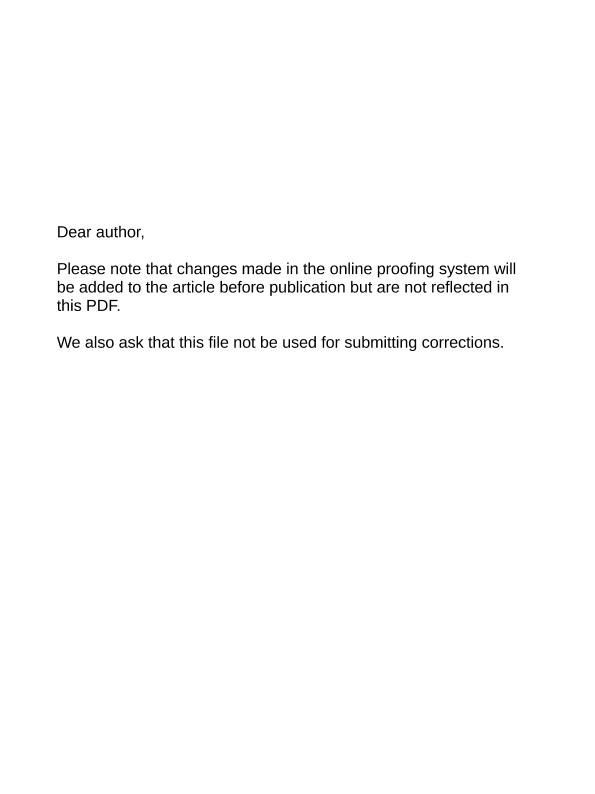Mostrar el registro sencillo del ítem
dc.contributor.author
Fontanarrosa, Gabriela

dc.contributor.author
Daza Vaca, Juan Diego

dc.contributor.author
Abdala, Virginia Sara Luz

dc.date.available
2018-11-20T22:10:15Z
dc.date.issued
2018-04
dc.identifier.citation
Fontanarrosa, Gabriela; Daza Vaca, Juan Diego; Abdala, Virginia Sara Luz; Cretaceous fossil gecko hand reveals a strikingly modern scansorial morphology: Qualitative and biometric analysis of an amber-preserved lizard hand; Academic Press Ltd - Elsevier Science Ltd; Cretaceous Research; 84; 4-2018; 120-133
dc.identifier.issn
0195-6671
dc.identifier.uri
http://hdl.handle.net/11336/64819
dc.description.abstract
Gekkota (geckos and pygopodids) is a clade thought to have originated in the Early Cretaceous and that today exhibits one of the most remarkable scansorial capabilities among lizards. Little information is available regarding the origin of scansoriality, which subsequently became widespread and diverse in terms of ecomorphology in this clade. An undescribed amber fossil (MCZ R–190835) from mid-Cretaceous outcrops of the north of Myanmar dated at 99 Ma, previously assigned to stem Gekkota, preserves carpal, metacarpal and phalangeal bones, as well as supplementary climbing structures, such as adhesive pads and paraphalangeal elements. This fossil documents the presence of highly specialized adaptive structures. Here, we analyze in detail the manus of the putative stem Gekkota. We use morphological comparisons in the context of extant squamates, to produce a detailed descriptive analysis and a linear discriminant analysis (LDA) based on 32 skeletal variables of the manus. The comparative sample includes members of 15 extant squamate families (Agamidae, Dactyloidae, Iguanidae, Leiosauridae, Liolaemidae, Polychrotidae, Tropiduridae, Diplodactylidae, Eublepharidae, Gekkonidae, Phyllodactylidae, Sphaerodactylidae, Gymnophthalmidae, Teiidae, and Scincidae). Although the fossil manus is qualitatively more similar to that of members of Gekkota, the LDA analysis places it in a morphozone shared by Gekkota and Scincomorpha. This result is particularly interesting, given that despite the presence of paraphalangeal structures had only been reported in extant geckos of the families Gekkonidae and Phyllodactylidae, the usage of an adhesive subdigital system to climb originated independently in Gekkota, Scincidae, and Dactyloidae.
dc.format
application/pdf
dc.language.iso
eng
dc.publisher
Academic Press Ltd - Elsevier Science Ltd

dc.rights
info:eu-repo/semantics/openAccess
dc.rights.uri
https://creativecommons.org/licenses/by-nc-sa/2.5/ar/
dc.subject
Hand Evolution
dc.subject
Paraphalanges
dc.subject
Squamata Paleobiology
dc.subject.classification
Otras Ciencias Biológicas

dc.subject.classification
Ciencias Biológicas

dc.subject.classification
CIENCIAS NATURALES Y EXACTAS

dc.title
Cretaceous fossil gecko hand reveals a strikingly modern scansorial morphology: Qualitative and biometric analysis of an amber-preserved lizard hand
dc.type
info:eu-repo/semantics/article
dc.type
info:ar-repo/semantics/artículo
dc.type
info:eu-repo/semantics/publishedVersion
dc.date.updated
2018-10-23T17:52:14Z
dc.journal.volume
84
dc.journal.pagination
120-133
dc.journal.pais
Países Bajos

dc.journal.ciudad
Amsterdam
dc.description.fil
Fil: Fontanarrosa, Gabriela. Consejo Nacional de Investigaciones Científicas y Técnicas. Centro Científico Tecnológico Conicet - Tucuman. Instituto de Biodiversidad Neotropical. Universidad Nacional de Tucuman. Facultad de Ciencias Naturales e Instituto Miguel Lillo. Instituto de Biodiversidad Neotropical. Instituto de Biodiversidad Neotropical; Argentina
dc.description.fil
Fil: Daza Vaca, Juan Diego. Sam Houston State University. Department of Biological Sciences; Estados Unidos. Consejo Nacional de Investigaciones Científicas y Técnicas. Centro Científico Tecnológico - Tucumán. Unidad Ejecutora Lillo; Argentina
dc.description.fil
Fil: Abdala, Virginia Sara Luz. Consejo Nacional de Investigaciones Científicas y Técnicas. Centro Científico Tecnológico Conicet - Tucuman. Instituto de Biodiversidad Neotropical. Universidad Nacional de Tucuman. Facultad de Ciencias Naturales e Instituto Miguel Lillo. Instituto de Biodiversidad Neotropical. Instituto de Biodiversidad Neotropical; Argentina
dc.journal.title
Cretaceous Research

dc.relation.alternativeid
info:eu-repo/semantics/altIdentifier/url/https://www.sciencedirect.com/science/article/pii/S0195667117302392
dc.relation.alternativeid
info:eu-repo/semantics/altIdentifier/doi/http://dx.doi.org/10.1016/j.cretres.2017.11.003
Archivos asociados
